George Washington Bridge
| George Washington Bridge | |
|---|---|
 |
|
| Carries | 14 lanes (8 upper, 6 lower) of I-95/US 1/US 9/US 46, pedestrians and bicycles |
| Crosses | Hudson River |
| Locale | Fort Lee, New Jersey and Manhattan in New York City |
| Maintained by | Port Authority of New York and New Jersey |
| Design | Double-decked Suspension bridge |
| Longest span | 3,500 ft (1,100 m) |
| Total length | 4,760 ft (1,450 m) |
| Width | 119 ft (36 m) |
| Height | 604 ft (184 m)[1] |
| Vertical clearance | 14 ft (4.3 m) (upper level), 13.5 ft (4.1 m) (lower level) |
| Clearance below | 212 ft (65 m) at mid-span |
| AADT | 295,649 (2007)[2] |
| Opening date | October 24, 1931 (upper level) August 29, 1962 (lower level) |
| Toll | Cars $8.00 ($8 peak / $6 off-peak with E-ZPass) $2 when carpooling w/ 3 people or more w/ EZ-Pass (cars only) (eastbound only) |
| Coordinates | |
The George Washington Bridge (known informally as the GW Bridge[3], the GWB[4], the GW[5], or the George[6]) is a suspension bridge spanning the Hudson River, connecting the Washington Heights neighborhood in the borough of Manhattan in New York City to Fort Lee in New Jersey by means of Interstate 95, U.S. Route 1/9. U.S. Route 46, which is entirely in New Jersey, ends halfway across the bridge at the state border. The GWB is considered one of the world's busiest bridges in terms of vehicle traffic.[7] The bridge carried 147,912,000 vehicles in 2007, according to the Port Authority of New York and New Jersey — the bi-state government agency that owns and operates several area bridges, tunnels, and airports.[1]
The GW span is the fourth longest suspension bridge in the United States. It contains two levels — an upper level with four lanes in each direction and a lower level with three lanes in each direction, for a total of 14 lanes of travel. Additionally, the bridge houses a path on each side of the bridge's upper level for pedestrian traffic. The speed limit on the bridge is 45 mph (70 km/h), though heavy traffic frequently makes it difficult to reach such speeds, especially during the morning and evening rush hours into and out of New York City.
Contents |
History
Groundbreaking for the new bridge began in October 1927, a project of the Port of New York Authority. Its chief engineer was Othmar Ammann, with Cass Gilbert as architect. The bridge was dedicated on October 24, 1931, and opened to traffic the following day. Initially named the "Hudson River Bridge," the bridge is named in honor of George Washington, the first President of the United States. The Bridge is near the sites of Fort Washington (on the New York side) and Fort Lee (in New Jersey), which were fortified positions used by General Washington and his American forces in his unsuccessful attempt to deter the British occupation of New York City in 1776 during the American Revolutionary War. Washington evacuated Manhattan by crossing between the two forts. In 1910 the Washington Chapter of the Daughters of the American Revolution erected a stone monument to the Battle of Fort Washington. The monument is located about 100 yards (91 m) northeast of the Little Red Lighthouse, up the hill towards the eastern bridge anchorage.pix
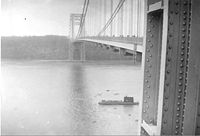
When it opened, the bridge had the longest main span in the world; at 1,067 m (3,500 ft), it nearly doubled the previous record of 564 m (1,850 ft), which had been held by the Ambassador Bridge. (The record has since been exceeded numerous times.) The total length of the bridge is 1,451 m (4,760 ft).
As originally built, the bridge offered six lanes of traffic, but in 1946, two additional lanes were provided on what is now the upper level. A second, lower deck, which had been anticipated in Ammann's original plans, was added, opening to the public on August 29, 1962. This lower level has been waggishly nicknamed "Martha." The additional deck increased the capacity of the bridge by 75 percent, making the George Washington Bridge the world's only 14-lane suspension bridge, providing eight lanes on the upper level and six on the lower deck.
The original design for the towers of the bridge called for them to be encased in concrete and granite. However, due to cost considerations during the Great Depression and favorable aesthetic critiques of the bare steel towers, this was never done. The exposed steel towers, with their distinctive criss-crossed bracing, have become one of the bridge's most identifiable characteristics. Le Corbusier (Charles-Edouard Jeanneret) said of the unadorned steel structure:
"The George Washington Bridge over the Hudson is the most beautiful bridge in the world. Made of cables and steel beams, it gleams in the sky like a reversed arch. It is blessed. It is the only seat of grace in the disordered city. It is painted an aluminum color and, between water and sky, you see nothing but the bent cord supported by two steel towers. When your car moves up the ramp the two towers rise so high that it brings you happiness; their structure is so pure, so resolute, so regular that here, finally, steel architecture seems to laugh. The car reaches an unexpectedly wide apron; the second tower is very far away; innumerable vertical cables, gleaming against the sky, are suspended from the magisterial curve which swings down and then up. The rose-colored towers of New York appear, a vision whose harshness is mitigated by distance." (When the Cathedrals were White, 1947.)
Following the September 11th attacks on New York and Washington, the Port Authority prohibited people from taking photographs on the premises of the bridge due to the fear that terrorist groups might study any potential photographs in order to plot a terrorist attack on the bridge. Such prohibitions have since been lifted. As the enclosed lower level is more vulnerable to hazardous material (HAZMAT) incidents than the upper level, most HAZMATs have been prohibited there even before the September 11th attacks. [8] The George Washington Bridge is home to the world's largest free-flying American flag. The flag, located under the upper arch of the New Jersey tower, drapes vertically for 90 feet (27 m) and is 60 feet (18 m) wide .The flag weighs 450 pounds. The flag's stripes are about 5 feet (1.5 m) wide and the stars measure about 4 feet (1.2 m) in diameter. Weather permitting, the flag is flown on Martin Luther King, Jr. Day, President's Day, Memorial Day, Flag Day, Independence Day, Labor Day, Columbus Day, and Veterans Day, as well as on dates honoring those lost in the September 11, 2001 attacks.[9][10]
Road connections
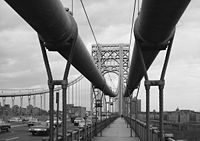
The George Washington Bridge carries I-95, US-1, and US-9 between New Jersey and New York. US-46 terminates at the state border in the middle of the bridge. I-80 and NJ-4 also feed into the bridge but end before reaching it. On the New Jersey side of the Bridge, the Palisades Interstate Parkway connects directly to the bridge's upper level (there were plans to give direct access to the lower level from the parkway but the plan has been postponed), and the New Jersey Turnpike connects to both levels of the bridge.
On the New York side, the twelve-lane Trans-Manhattan Expressway heads east across the narrow neck of upper Manhattan, from the bridge to the Harlem River, providing access from both decks to 178th Street, the Henry Hudson Parkway and Riverside Drive on the West Side of Manhattan, and to Amsterdam Avenue and the Harlem River Drive on the East Side. The Expressway connects directly with the Alexander Hamilton Bridge, which spans the Harlem River as part of the Cross-Bronx Expressway (I-95), providing access to the Major Deegan Expressway (I-87). Heading towards New Jersey, local access to the Bridge is available from 179th Street. There are also ramps connecting the bridge to the George Washington Bridge Bus Terminal, a commuter bus terminal with direct access to the New York City Subway at the 175th Street (A) station on the IND Eighth Avenue Line.
Tolls
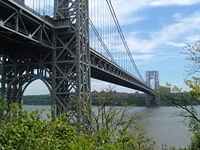
Current tolls for cars are as follows: $8 if paying with cash, $8 peak hours with E-ZPass, and $6 off-peak hours with E-ZPass. A special discounted carpool toll ($2) is available for cars with three or more passengers, at all times, with E-ZPass, who proceed through a staffed toll lane (provided they have previously opted-in to the free "Carpool Plan"). Current tolls for motorcycles are $7 cash, $7 peak hours with E-ZPass, and $5 off-peak with E-ZPass. Trucks are charged $8 per axle, with significantly discounted off-peak and overnight tolls.[11] The toll is only charged one way (eastbound), which is how all Hudson River crossings are tolled. Foot traffic and cyclists cross for free on sidewalks, one on each side of the upper deck, offering spectacular views of the Hudson River, the Manhattan skyline and the New Jersey Palisades. Pedestrians had to pay tolls of 10 cents shortly after the bridge opened, but non-motorized traffic is no longer tolled. The George Washington Bridge takes in approximately $1 million per day in tolls.
In January 2007 the Port Authority of New York and New Jersey announced a deal with Geico, the auto insurance giant, that included the posting of a large billboard on top of the toll plaza that said "Geico Drive Safely," and Geico signs on the tollbooths and approach roads, some of which would feature the insurer's signature gecko. The arrangement would have provided the agency with $3.2 million over two years.[12] A week later, however, the Port Authority canceled the contract with Geico after criticism that the signs would mar the landmarked bridge, that the Port Authority had failed to negotiate a good price for the deal and that the placement of the signs might violate Fort Lee's regulations.[13]
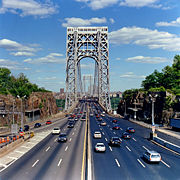
Non-motorized access
The George Washington Bridge is also popular among sightseers and commuters traveling by foot, bicycle, or roller skates. The South sidewalk (accessible by a long, steep ramp on the Manhattan side of the bridge) is shared by cyclists and pedestrians, with a level surface from end to end. The entrance in Manhattan is at 178th Street, just west of Cabrini Boulevard which also has access to the Hudson River Greenway north of the bridge. The sidewalk is accessible on the New Jersey side from Hudson Terrace, where a gate open in daytime and evening allows pedestrians and bikes to pass. Also on Hudson Terrace, less than one hundred yards north of the bike/ped entrance, walkers will find the start of the Long Path hiking trail, which leads after a short walk to some spectacular views of the bridge, and continues north towards Albany, New York.
The Port Authority[14] closed the North Sidewalk at all times in 2008. Though offering direct access into Palisades Interstate Park, the North sidewalk requires stairway climbs and descents on both sides, always an inconvenience and obstacle to handicapped people, and a risk in poor weather conditions.
Transportation Alternatives, a New York City advocacy group, has proposed an enhanced River Road connector in Fort Lee, which would create safer pedestrian and bicycle access to the George Washington Bridge on the New Jersey side of the bridge.[15]
Alternate routes
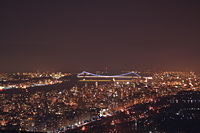

Motorists and trucks traveling from New England states towards Pennsylvania, or from the direction of Pennsylvania towards New England, often take the Tappan Zee Bridge crossing instead of the George Washington Bridge as this effectively bypasses New York City and the associated traffic.
References
- ↑ 1.0 1.1 "Port Authority of New York and New Jersey - George Washington Bridge". Retrieved on 2008-08-16.
- ↑ "Port Authority of New York and New Jersey - George Washington Bridge Statistics". Retrieved on 2008-07-29.
- ↑ Rose, Lacey. "Inside The Booth", Forbes, March 2, 2006. Accessed January 15, 2008. "Like the PATH trains, which also connect New York to New Jersey, the G.W. Bridge is run by the Port Authority of New York and New Jersey, a public agency that employees 7,000 workers and has annual revenues of $2.9 billion."
- ↑ Toolen, Tom. "BRIDGES KEEP PHOTOGRAPHER IN SUSPENSE", The Record (Bergen County), September 27, 1995. Accessed January 15, 2008. "Frieder calls the GWB 'the most beautiful suspension bridge in the world...'"
- ↑ Jones, Charisse. "Upkeep costs rise as USA's bridges age", USA Today, October 20, 2006. Accessed January 15, 2008. "The George Washington Bridge — locals call it 'the GW' — is one of a collection of dazzling spans that link New York's five boroughs or the city and New Jersey."
- ↑ Barron, James. "PUBLIC LIVES; Bridge Photographer With a Taste for Trivia", The New York Times, July 22, 1998. Accessed January 15, 2008. "Mr. Frieder takes it for granted that anyone who has ever heard a radio traffic report will know that the G.W.B., a k a the George, is the George Washington Bridge."
- ↑ George Washington Bridge turns 75 years old: Huge flag, cake part of celebration, Times Herald-Record, October 24, 2006. "The party, however, will be small in comparison to the one that the Port Authority of New York and New Jersey organized for 5,000 people to open the bridge to traffic in 1931. And it won't even be on what is now the world's busiest bridge for fear of snarling traffic."
- ↑ http://www.panynj.gov/CommutingTravel/bridges/pdfs/red_book.pdf Port Authority hazardous materials transportation regulations
- ↑ George Washington Bridge, Port Authority of New York and New Jersey. Accessed May 28, 2007.
- ↑ George Washington Bridge Interesting Facts, Port Authority of New York and New Jersey. Accessed May 28, 2007.
- ↑ Port Authority Toll Rates, accessed September 6, 2008.
- ↑ The New York Times. "With Ad Deal, Insurer Wades Into Bridge Traffic.", January 4, 2006.
- ↑ Belson, Ken. "Agency Cancels Insurer’s Ads for George Washington Bridge.", The New York Times, January 9, 2007.
- ↑ The north sidewalk is closed around-the-clock. Port Authority of New York and New Jersey.
- ↑ Support Grows in NJ for GW Bridge to "River Road" Connector Path, Transportation Alternatives Magazine, Summer 2003.
External links
- Port Authority of New York and New Jersey George Washington Bridge Official Site
- NYCRoads.com: George Washington Bridge
- George Washington Bridge Webcam
- Fort Lee Online
- Library of Congress "Local Legacies"
- Official site of Transportation Alternatives, New York
- George Washington Bridge in the Structurae database
- George Washington Bridge is at coordinates
|
|||||||||||
|
||||||||
|
||||||||